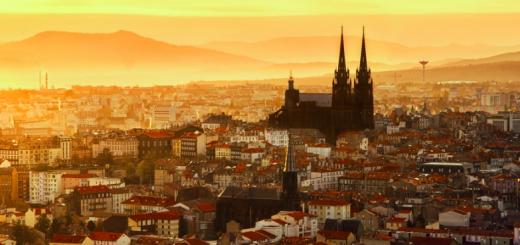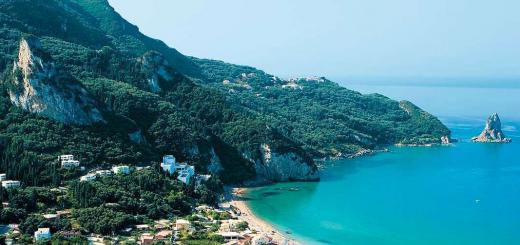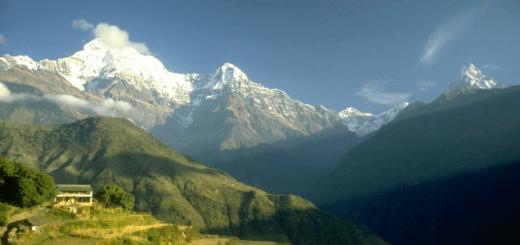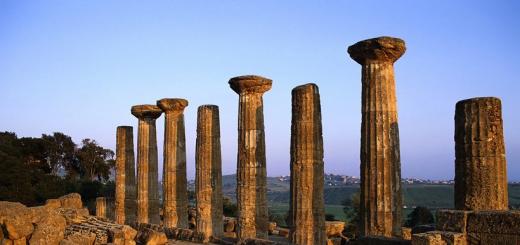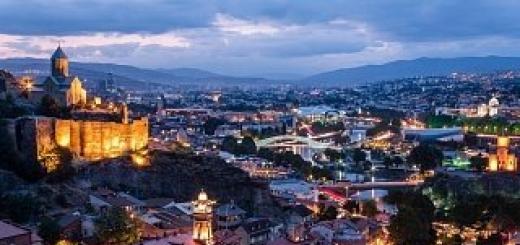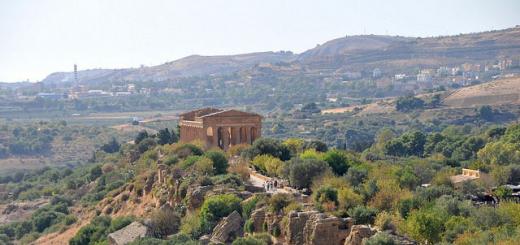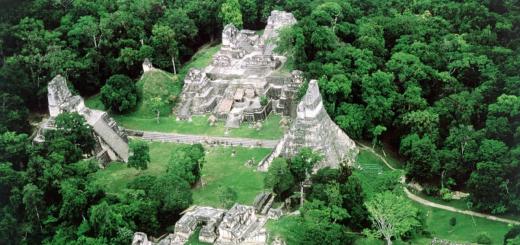Himalayas: the highest mountains in the world
5 (100%) 2 votesThe Himalayas consist of approximately 30 mountains, nine of which are the highest peaks on the planet, including Everest. Extreme lovers from all over the planet consider this place as a center of mountaineering. We will tell you the most interesting facts about the Himalayas.
Geographic location

The Himalayas are located on the territory of five states:
- India;
- Nepal;
- Bhutan;
- China;
- Pakistan
The mountains have a total area of 153,295,000 sq. km, occupy 0.4% of the entire surface of the earth.
The mountain range of the Himalayas is the most impregnable region of the Earth.

If we do not take into account Antarctica and the Arctic, then the Himalayas are in the lead in terms of deposits of ice and snow. A great many glaciers contain enough water for rivers and lakes, which are here in considerable quantity.
Huge rivers originate in the Himalayas and highlands of Tibet:
- Ganges;
- Yamuna.

The tops of the mountains are unsuitable for human life due to the harsh climate: cold, lack of oxygen, and strong winds. In the valleys between the mountains there is a small number of settlements, with few inhabitants.
The local population lives off tourism and accompanying climbers who wish to see or conquer the mountain peaks.
Local religions and beliefs

The main religions of the Himalayan inhabitants are:
- Islam;
- Buddhism;
- Hinduism.
The story of Bigfoot living somewhere in the mountains has become the most popular myth in the Himalayas.
According to Hindu mythology, this place is considered the refuge of Lord Shiva.
The highest mountains of the Himalayas:

- Chomolungma, height 8,848 km.
- Kangchenjunga, height 8,586 km.
- Lhotse, height 8,516 km.
- Makalu, height 8,463 km.
- Cho Oyu, height 8,201 km.
- Dhaulagiri, height 8,167 km.
- Manaslu, height 8,156 km.
- Nanga Parbat, height 8,126 km.
- Annapurna, height 8091 km.
- Shishabangma, height 8027 km.
Many people die every year trying to conquer the peaks of the Himalayas. But the danger does not stop real extreme sportsmen and travelers who cannot live without risk.
Mountains hold many dangerous surprises, such as rapidly changing weather conditions with gusty winds, or lack of oxygen.
Vegetation

Vegetation in the Himalayas varies with altitude:
- swampy forest thickets predominate in the valleys;
- green tropical jungle, coniferous and deciduous forests grow a little higher;
- further on are alpine meadows;
- at the level of 3500 m only bushes grow.
The purest plants for medicine grow exclusively in the foothills.
There are quite a lot of Hindu temples and Buddhist monasteries in the Himalayas.
Valley of Flowers is a national park. It is located in the western Himalayas and is included in the UNESCO heritage list.
The Himalayan mountains are the largest mountain formations on the entire globe. They are located in Asia and are the property of five different states. It is worth noting that this mountain formation is located on the mainland called Eurasiaquot ;. According to one of the sources on the Internet, the highest point of the Himalayas is Mount Everest, reaching a height of more than 8800 meters.
The Himalayas are a large mountain range in southern Asia that forms a barrier between the Tibetan plateau in the north and the alluvial plains of the Hindustan Peninsula in the south.
They are part of Nepal, India, Pakistan, Tibet and Bhutan. The mountains are the highest in the world, reaching almost 9000 meters above sea level, more than 110 peaks rise to a height of 7300 meters or more above sea level. One of these peaks, Everest (Tibetan: Chomolungma; Chinese: Chomolungma Feng; Nepalese: Sagarmatha) is the highest in the world, at 8,850 meters. The Himalayas separate the Indian subcontinent from the interior of Asia. The word Himalaya means house of snow.
The Himalayas are the largest mountain system on Earth. The Himalayas are located at the junction of Central and South Asia. The length of this system is 2900 km long and 350 km wide. These mountains are located in the Tibet Autonomous Region of China, India, Nepal, Pakistan, Bhutan and Bangladesh.
The question is very true and necessary, now they give such an ugly education in schools that it is just right to be enlightened on the Big Question. The Himalayas are located in southern Asia and partly in Central Asia. These mountains are ROOF OF THE WORLD " because there is the highest peak is Mount Everest. Its height is 8848 meters.

If we talk about the mainland where the Himalayas are located, then this mainland is called Eurasia. To be more precise, these mountains are located in Asia, on the territory of five countries. The length of the Himalayan mountains is more than 2900 km and has an area of about 650 thousand square kilometers.
The Himalayas are the highest mountain system on Earth. It is located on the mainland of Eurasia, between the Tibetan Plateau and the Indo-Gangetic Plain. The highest point of the Himalayas is Mount Everest (Chomolungma) - 8848 m above sea level.
Name Himalaya means Abode of snowsquot ;. The length of the mountain system reaches 2900 km, the width is about 350 km.
The Himalayas are located on the lands of such powers as China, India, Nepal, Pakistan, Bhutan and Bangladesh.
Coordinates: 2949?00? with. sh. 8323?31? in. d.?

The Himalayas is a whole mountain system, the length of which is about three thousand kilometers. The Himalayas are located in Eurasia, they cover many powers, including China, India, Pakistan, Bangladesh, etc. The highest mountain in this mountain system is Mount Everest.
The Himalayas, the abode of snows in Sanskrit, are located on the mainland of Eurasia. The highest mountain system on earth. The Himalayas separate the Tibetan Plateau in the north from the Indo-Gangetic Plain in the south. In the Himalayas are the territories of China, Nepal, Bhutan, Pakistan, India, Sikkim and Ladakh.
The length of the mountain range is about 3 thousand kilometers, the width is about 350 kilometers. In the west, it passes into the Pamir and Hindu Kush mountain systems.
On the territory of the Himalayas is the highest mountain on the planet - 8848 meters - Chomolungma (Everest), which in Nepalese means Goddess Mother of the Snows.
Fossils of fish are found in the mountains, which suggests that once the mountains were the bottom of the ancient ocean.

Himalayas is the highest mountain system on planet Earth. The Himalayas are located on the continent of Eurasia, on the border of Central and South Asia. Countries on whose territory the Himalayas are spread: China, India, Nepal, Pakistan, Bhutan.
Solarshakti / flickr.com View of the snowy Himalayas (Saurabh Kumar_ / flickr.com) Great Himalayas - view on the way to Leh from Delhi (Karunakar Rayker / flickr.com) You will have to cross this bridge if you are going to Everest Base Camp (ilker ender / flickr.com) Greater Himalayas (Christopher Michel / flickr.com) Christopher Michel / flickr.com Christopher Michel / flickr.com Everest Sunset (旅者 河童 / flickr.com) Himalayas - From Airplane (Partha S. Sahana / flickr.com) Lukla Airport, Patan, Kathmandu. (Chris Marquardt / flickr.com) Valley of Flowers, Himalayas (Alosh Bennett / flickr.com) Himalayan Landscape (Jan / flickr.com) Ganges Bridge (Asis K. Chatterjee / flickr.com) Kanchenjunga, Indian Himalayas (A.Ostrovsky / flickr.com) Climber at sunset, Nepal Himalayas (Dmitry Sumin / flickr.com) Manaslu - 26,758 feet (David Wilkinson / flickr.com) Wildlife of the Himalayas (Chris Walker / flickr.com) Annapurna (Mike Behnken / flickr.com) ) On the border of India and Tibet in Kinnaur Himachal Pradesh (Partha Chowdhury / flickr.com) A beautiful place in Kashmir (Kashmir Pictures / flickr.com) Abhishek Shirali / flickr.com Parfen Rogozhin / flickr.com Koshy Koshy / flickr.com valcker / flickr.com Annapurna Base Camp, Nepal (Matt Zimmerman / flickr.com) Annapurna Base Camp, Nepal (Matt Zimmerman / flickr.com)
Where are the Himalaya mountains, the photos of which are so amazing? For most people, this question is unlikely to cause difficulty, at least they will answer exactly on which mainland these mountains stretch.

If you look at a geographical map, you can see that they are located in the northern hemisphere, in South Asia, between the Indo-Gangetic plain (in the south) and the Tibetan plateau (in the north).
In the west, they pass into the Karakoram and Hindu Kush mountain systems.
The peculiarity of the geographical position of the Himalayas is that they are located on the territory of five countries: India, Nepal, China (Tibet Autonomous Region), Bhutan and Pakistan. The foothills also cross the northern outskirts of Bangladesh. The name of the mountain system can be translated from Sanskrit as "abode of snows".
Height of the Himalayas
The Himalayas contain 9 of the 10 highest peaks on our planet, including the highest point in the world - Chomolungma, which reaches an altitude of 8848 m above sea level. Its geographic coordinates are 27°59′17″ north latitude 86°55′31″ east longitude. The average height of the entire mountain system exceeds 6000 meters.
The highest peaks of the Himalayas
Geographic description: 3 main steps
The Himalayas form three main steps: the Sivalik Range, the Lesser Himalayas and the Greater Himalayas, each of which is higher than the previous one.
- Sivalik Range- the southernmost, lowest and most geologically young step. It stretches for about 1700 km from the Indus Valley to the Brahmaputra Valley with a width of 10 to 50 km. The height of the ridge does not exceed 2000 m. Sivalik is located mainly in Nepal, as well as in the Indian states of Uttarakhand and Himachal Pradesh.
- The next step is the Lesser Himalayas, it passes north of the Sivalik ridge, parallel to it. The average height of the ridge is about 2500 m, and in the western part it reaches 4000 m. The Sivalik ridge and the Lesser Himalayas are strongly cut by river valleys, breaking up into separate massifs.
- Greater Himalayas- the northernmost and highest step. The height of individual peaks here exceeds 8000 m, and the height of the passes is more than 4000 m. Glaciers are widely developed. Their total area exceeds 33,000 square kilometers, and the total fresh water reserves in them are about 12,000 cubic kilometers. One of the largest and most famous glaciers - Gangotri, is the source of the Ganges River.
Rivers and lakes of the Himalayas
The three largest rivers of South Asia - the Indus, the Ganges and the Brahmaputra - begin in the Himalayas. The rivers of the western extremity of the Himalayas belong to the Indus basin, and almost all other rivers belong to the Ganges-Brahmaputra basin. The easternmost edge of the mountain system belongs to the Irrawaddy basin.
There are many lakes in the Himalayas. The largest of them are Lake Bangong Tso (700 km²) and Yamjo Yumtso (621 km²). Lake Tilicho is located at an absolute mark of 4919 m, which makes it one of the highest in the world.
Climate
The climate in the Himalayas is quite diverse. Monsoons have a strong influence on the southern slopes. The amount of precipitation here increases in the direction from west to east from less than 1000 mm to more than 4000 mm.

On the border of India and Tibet in Kinnaur Himachal Pradesh (Partha Chowdhury / flickr.com)
The northern slopes, on the other hand, are in the rain shadow. The climate here is dry and cold.
In the highlands there are severe frosts and winds. In winter, temperatures can drop to minus 40 °C or even lower.
The Himalayas have a strong influence on the climate of the entire region. They are a barrier to cold dry winds blowing from the north, which makes the climate of the Indian subcontinent much warmer compared to neighboring regions of Asia located at the same latitudes. In addition, the Himalayas are a barrier to the monsoons blowing from the south and bringing a huge amount of rainfall.
High mountains do not allow these humid air masses to pass further north, which makes the climate of Tibet very dry.
There is an opinion that the Himalayas played a significant role in the formation of the deserts of Central Asia, such as the Takla-Makan and the Gobi, which is also explained by the rain shadow effect.
Origin and geology
Geologically, the Himalayas are one of the youngest mountain systems in the world; refers to the Alpine folding. It is composed mainly of sedimentary and metamorphic rocks, crumpled into folds and raised to a considerable height.
The Himalayas were formed as a result of the collision of the Indian and Eurasian lithospheric plates, which began approximately 50-55 million years ago. During this collision, the ancient Tethys Ocean closed and an orogenic belt was formed.
Flora and fauna
The flora of the Himalayas is subject to altitudinal zonation. At the foot of the Sivalik Range, the vegetation is represented by swampy forests and thickets, known locally as "terai".

Himalayan Landscape (Jan / flickr.com)
Above, they are replaced by evergreen tropical, deciduous and coniferous forests, and even higher - by alpine meadows.
Deciduous forests begin to prevail at absolute elevations of more than 2000 m, and coniferous forests - above 2600 m.
At an altitude of more than 3500 m, shrub vegetation already predominates.
On the northern slopes, where the climate is much more arid, the vegetation is much poorer. Mountain deserts and steppes are common here. The height of the snow line varies from 4500 (southern slopes) to 6000 m (northern slopes).

Wildlife of the Himalayas (Chris Walker / flickr.com)
The local fauna is quite diverse and, like the vegetation, depends mainly on the height above sea level. The fauna of the tropical forests of the southern slopes is typical for the tropics. Elephants, rhinos, tigers, leopards, and antelopes are still found here in the wild; numerous monkeys.
Higher up, there are Himalayan bears, mountain goats and sheep, yaks, etc. In the highlands, there is still such a rare animal as the snow leopard.
The Himalayas are home to many different protected areas. Among them, it is worth noting the Sagarmatha National Park, within which Everest is partially located.
Population
Most of the population of the Himalayas lives in the southern foothills and in the intermountain basins. The largest basins are Kashmir and Kathmandu; these regions are very densely populated, and almost all the land is cultivated.

Bridge over the Ganges (Asis K. Chatterjee / flickr.com)
Like many other mountainous regions, the Himalayas are characterized by great ethnic and linguistic diversity.
This is due to the inaccessibility of these places, due to which the population of almost every valley or basin lived very apart.
Contacts even with neighboring regions were minimal, since in order to get to them, it is necessary to overcome high mountain passes, which in winter are often covered with snow, and they become completely impassable. In this case, some intermountain basin could be completely isolated until next summer.
Almost the entire population of the region speaks either Indo-Aryan languages, which belong to the Indo-European family, or Tibeto-Burman languages, which belong to the Sino-Tibetan family. Most of the population professes Buddhism or Hinduism.
The most famous people of the Himalayas are the Sherpas, who live in the highlands of Eastern Nepal, including in the Everest region. They often work as guides and porters on expeditions to Chomolungma and other peaks.

Annapurna Base Camp, Nepal (Matt Zimmerman / flickr.com)
Sherpas have hereditary high-altitude adaptation, thanks to which, even at very high altitudes, they do not suffer from altitude sickness and do not need additional oxygen.
Most of the population of the Himalayas is employed in agriculture. In the presence of a sufficiently flat surface and water, people cultivate rice, barley, oats, potatoes, peas, etc.
In the foothills and in some intermountain basins, more heat-loving crops are also grown - citrus fruits, apricots, grapes, tea, etc. In the highlands, the breeding of goats, sheep and yaks is common. The latter are used as a beast of burden, as well as for meat, milk and wool.
Sights of the Himalayas
In the Himalayas there are many different attractions. This region has a huge number of Buddhist monasteries and Hindu temples, as well as simply places considered sacred in Buddhism and Hinduism.

Valley of Flowers, Himalayas (Alosh Bennett / flickr.com)
In the foothills of the Himalayas, the Indian city of Rishikesh is located, which is sacred to Hindus, and is also widely known as the yoga capital of the world.
Another sacred Hindu city is Hardwar, located at the point where the Ganges descends from the Himalayas to the plain. From Hindi, its name can be translated as "gateway to God."
Of the natural attractions, it is worth mentioning the Valley of Flowers National Park, located in the Western Himalayas, in the Indian state of Uttarkhand.
The valley fully justifies its name: it is a continuous flower carpet, quite unlike the usual alpine meadows. Together with the Nanda Devi National Park, it is a UNESCO heritage site.
Tourism
Mountaineering and hiking in the mountains are popular in the Himalayas. Of the hiking routes, the most famous track around Annapurna, passing along the slopes of the mountain range of the same name, in the north of the central part of Nepal.

Climber at sunset, Nepal Himalayas (Dmitry Sumin / flickr.com)
The length of the route is 211 km, and its altitude varies from 800 to 5416 m.
Sometimes tourists combine this track with a hike to Lake Tilicho, located at an absolute mark of 4919 m.
Another popular route is the Manaslu trek, which runs around the Mansiri-Himal mountain range and overlaps with the Annapurna route.
How long it will take to complete these routes depends on the physical fitness of the person, the time of year, weather conditions and other factors. In high altitude areas, you should not climb too quickly to avoid symptoms of altitude sickness.
The conquest of the Himalayan peaks is quite difficult and dangerous. It requires good training, equipment and implies the presence of mountaineering experience.
The types of landscapes and the possibility of conquering the mountains of eight-thousanders attract climbers from all over the world. Myths and legends envelop this piece of land, marked by the brightest spot (on a scale of heights) on the physical map of Eurasia. At the same time, the Himalayan system of hills is the youngest on the planet.
The highest mountain range of the Himalayas is located in South Asia, it stretches from west to east, its length is over 2400 km, its width is in the range of 180-350 km, and its area is about 650 km 2.
Regarding geographical objects, the ridge borders:
- north - Tibetan Plateau;
- south - Indo-Gangetic lowland;
- east - the valley of the Brahmaputra river;
- West - Indus Gorge.
The territory of the Himalayan mountains was divided among themselves by several Asian countries, the information is given in table 1.
Table 1.
| No. p / p | State | Capital | Location on the Himalayan range |
| 1. | Islamic Republic of Pakistan | Islamabad | West Side |
| 2. | Republic of India | New Delhi | Western and central parts |
| 3. | Tibet Autonomous Region of the People's Republic of China | Lhasa PRC - Beijing | Northwestern part |
| 4. | Federal Democratic Republic of Nepal | Kathmandu | central part |
| 5. | Kingdom of Bhutan | Thimphu | East End |
| 6. | People's Republic of Bangladesh | Dhaka | Eastern foothills |
Origin of the Himalayas and Geology
The Himalayan mountains on the map of geologists are marked as the youngest on Earth.
The age of the mountains is determined by their relief: the sharpness, the amplitude of the heights, the steepness of the slopes certifies their youth - the Himalayas belong to this type. The beginning of the formation of the system is about 38 million years ago. And in our time, tectonic movements do not stop, they just become less intense.
 There is a historical and geological theory, according to which 200 million years ago there was one single continent on the globe. Under the influence of changes within the earth, it split into several continents.
There is a historical and geological theory, according to which 200 million years ago there was one single continent on the globe. Under the influence of changes within the earth, it split into several continents.
 Over time, they changed and collided with each other. So the Hindustan and Asian lithospheric plates collided, from this edge of both continents they deformed with the formation of high mountain ranges.
Over time, they changed and collided with each other. So the Hindustan and Asian lithospheric plates collided, from this edge of both continents they deformed with the formation of high mountain ranges.
During formation, the massif was divided into 3 conditional steps, starting from the south:
- The southern step of the Himalayas is the Sivalik Mountains. Its height does not exceed 1 km, width 10-50 km. There are several ranges and the Potvar Plateau in the mountain structure.
- Small Himalayas. The width of the vast highlands is 80-100 km, the average height is 3.5-4 km, there are peaks, the highest is 6.5 km. The picturesque valleys of Kashmir and Kathmandu stretch between the Dauladar border range and the main Himalayan range.
- Big Himalayas. The chain of ridges is broken into separate structures. The width reaches 90 km, the average height of the peaks is 5.5-6 km, it has 10 mountain ranges with peaks over 8 km.
Development and interesting facts
The development of mountains is associated with the desire to conquer the highest earthly peaks.
In total, there are 14 massifs on Earth with peaks above 8 km, the main share is in the Himalayas.
There are 10 mountain structures in which the heights of the peaks exceed this limit. Each of them was conquered by climbers more than once. But the most desirable goal of the climber is to conquer the highest peak of the planet - Chomolungma.
Some climbing facts:

- The first summit of Annapurna was conquered in 1950 by the Frenchmen M. Erzog and L. Lachenal. It was the first world conquest of the eight-thousander peak.
- The first ascent of Chomolungma in 1953 was made by New Zealander E. Hillary with Sherpa T. Norgay. Sherpas are the people of Nepal, the best guides in the mountains.
- Japanese Junko Tabei in 1976 was the first woman to conquer Chomolungma. The first European in 1978 was the Pole V. Rutkevich.
- The oldest person who conquered Chomolungma is 76-year-old Nepalese M.B. Shirchan in 2008. The youngest is 13-year-old Californian D. Romero in 2010.
- A group of 11 Russians conquered Chomolungma for the first time in 1982. The first Russian woman E. Ivanova conquered the height in 1990.
- The highest peak was conquered 3700 times, 570 climbers died during the ascents.
Peaks
Separately standing mountain structures can have several peaks over 8 km. A brief description is provided in Table 2. 
Table 2.
| No. p / p | Array name | Height, m | year of conquest | The country | Short description |
| 1. | Chomolungma (Everest) | 8848 | 1953 | Nepal, Tibetan AR | It has 2 peaks above 8 km. Part of Sagarmatha National Park (Nepal) |
| 2. | Kanchenjunga | 8586 | 1955 | Nepal, India | An array of 5 peaks, 4 of them are higher than 8 km. Part of a mountain in Kanchenjunga National Park |
| 3. | Lhotse | 8516 | 1956 | Nepal, Tibetan AR | An array of 3 peaks, all above 8 km |
| 4. | Makalu | 8463 | 1955 | Nepal, Tibetan AR | Consists of 2 peaks, both above 8 km |
| 5. | Cho Oyu | 8201 | 1954 | Nepal, Tibetan AR | It is part of the Chomolungma massif. Part of Sagarmatha National Park (Nepal) |
| 6. | Dhaulagiri | 8167 | 1960 | Nepal | An array of 11 peaks, 10 of which are higher than 7 km |
| 7. | Manaslu | 8156 | 1956 | Nepal | An array of 3 peaks, one above 7 km, the other - 6 km |
| 8. | Nanga Parbat | 8126 | 1953 | Pakistan | Consists of 4 peaks, 2 - from 7 km, 1 - from 6 km |
| 9. | Annapurna | 8091 | 1950 | Nepal | The ridge has a length of 55 km, 13 peaks are distinguished above 7 km, and 16 - 6 km |
| 10. | Shishabangma | 8027 | 1964 | Tibetan AR | It is part of the Langtang ridge, has 3 peaks, the height of two is above 8 km |
Weather
The Himalayan mountains on the map are indicative and are a barrier that separates the southern Indian lowland from the northern Tibetan plateau.
On the slopes on the northern side, the climate is continental cold with rare precipitation barely reaching 100 mm per year. Monsoon winds blow in the south, bringing heavy rainfall. During the summer period, precipitation up to 4 m falls in the eastern part, less in the west - more than 1 m.
 At the tops of the system, the temperature in winter is up to -40°С, and in summer it is not higher than -25°С. Due to constant winds, weather conditions can change dramatically. Hurricane winds often blow, sometimes reaching speeds of up to 150 km/h.
At the tops of the system, the temperature in winter is up to -40°С, and in summer it is not higher than -25°С. Due to constant winds, weather conditions can change dramatically. Hurricane winds often blow, sometimes reaching speeds of up to 150 km/h.
On the southern slope, the weather has 4 seasons:
- April-June is a cool spring with a lush growth of herbs and flowers.
- July-August is the summer rainy season with fogs, the flora develops especially rapidly.
- September-October - warm autumn, comfortable warm days come.
- November-March - frosty winter with snowfalls and clear days.
Himalayan water system
The water system of the Himalayas is connected with the ice and snow caps of the mountain peaks. The snow border of the south begins from the east at an altitude of 4.5 and from the west - 5.1-5.3 km.
 On the northern side, the border is higher - up to 1 km. Glaciers have formed on all high mountain peaks, in the west they have a valley character (the tongue of the glacier is located in the valley), in the east - dendritic (valley, formed from several tongues).
On the northern side, the border is higher - up to 1 km. Glaciers have formed on all high mountain peaks, in the west they have a valley character (the tongue of the glacier is located in the valley), in the east - dendritic (valley, formed from several tongues).
 Glaciers give rise to numerous rivers and full-flowing rivers that pass through the next 2 steps of the Himalayas and flow down to the lowlands. Information about the most famous rivers is given in table 3.
Glaciers give rise to numerous rivers and full-flowing rivers that pass through the next 2 steps of the Himalayas and flow down to the lowlands. Information about the most famous rivers is given in table 3.
Table 3
| river name | Length, km | Source | mouth | Through which countries does it flow |
| indus | 3180 | Tibetan Plateau | Arabian Sea | China (TAR), India, Pakistan |
| Sutlej | 1536 | Tibetan Plateau | Indus River | China (TAR), India, Pakistan |
| Brahmaputra | 2896 | Confluence of the Jangtsi and Chema-Yundung rivers | strait of bengal | China (TAR), India, Bangladesh |
| Ganges | 2700 | The confluence of the Bhagirathi and Alaknanda rivers | strait of bengal | India, Bangladesh |
 The reservoirs for lakes are pits that appeared in the process of movement of ice masses. Another condition for the creation of lakes is the dams of mud masses during the movement of ice avalanches on rivers. The well-known lakes of the system are usually sacred and are symbols of religious worship. Table 4 provides brief information about some of the lakes.
The reservoirs for lakes are pits that appeared in the process of movement of ice masses. Another condition for the creation of lakes is the dams of mud masses during the movement of ice avalanches on rivers. The well-known lakes of the system are usually sacred and are symbols of religious worship. Table 4 provides brief information about some of the lakes.
Table 4
| lake name | Location in countries | Height above sea level, m |
| Ansu | North Pakistan, Kaghan Valley | 5027 |
| Pangong Tso | North of India, southwest of Tibet AR | 4334 |
| Manasarovar | Tibet AR, southwestern region | 4557 |
| Gosaikund | Nepal, north central part, Rusawa district | 4380 |
| mebarzo | Bhutan, Central District, on the Tang River, Bumthang Region | 3000 |
Flora and fauna
On the mountain ranges of the Himalayas, an altitudinal zonality of climatic conditions, the world of flora and fauna is formed. The stages of the eastern and western zones are different; information is presented in Table 5.
 Table 5
Table 5
| No. p / p | Belt height, km | Belt Description | Flora representatives | Fauna representatives |
| Eastern zone |
||||
| 1. | Up to 0.8-0.9 | Terai - swampy jungle | Khair, sissou, bamboo, orchids, creepers, rattan | Rhinos, deer, fallow deer barasingi, crocodiles |
| 2. | Up to 1-1.2 | Tropical evergreen forests | Lianas, epiphytes, sal tree, shoreya | |
| 3. | Up to 2 | Tropical, subtropical forests | Oaks, maples, magnolias, chestnuts, Nepalese alder | |
| 4. | Up to 2.5 | Evergreen and deciduous forests | Oaks, longleaf pines, epiphytes | Wild boars, serows, Himalayan taras, red pandas, pheasants, Danfe pheasants, deer, bears |
| 5. | Up to 3.2 | Forests are evergreen with an admixture of deciduous | Himalayan spruce, Neapolitan cherry, Simon's multiflorum, maples, hemlock, rhododendrons | |
| 6. | Up to 4 | evergreen forests | Himalayan fir, birch, rodendrons, junipers | |
| 7. | Up to 4.2 | Rodendrons, junipers, honeysuckle | Himalayan marmots, snow leopards, snowcock, pika, snow partridges, redstarts, musky deer, wild yaks, llamas | |
| 8. | Up to 5.2 | Alpine herbalists, flower beds, lichens, moss | ||
| Western zone |
||||
| 1. | Up to 1.5 | Rainforests | Chestnuts and oaks, creepers, longleaf pine | Gauras, buffaloes, tigers, leopards, deer |
| 2. | Until 3 | subtropical evergreen forests | Cedars, Himalayan cedars, spruces, oaks, firs, cedar, neem, banyan tree | Wild boars, serau, bears, red panda, pheasants, gorals |
| 3. | Up to 4.3 | Subalpine, alpine stripes | Rare birches, pines, rodendrons, mostly shrubs, thickets of sedges, mosses, lichens | Marmots, deer, yaks, llamas, snow leopards, snow partridge, redstarts, woodpeckers, mountain pheasants |
 The inhabitant of the northern slopes of the Himalayan mountains is the snow leopard.
The inhabitant of the northern slopes of the Himalayan mountains is the snow leopard. The northern slopes are distinguished by a harsh climate, where even in summer the above-zero temperature rarely occurs at noon, at night it falls into the minus zone. Therefore, the vegetation, the animal world is very scarce.
parks and valleys
The Himalayan mountains (on the map you can see the presence of numerous national parks, reserves) have protective zones that are created to protect the unique wildlife.
They can be used for the purposes of scientific geographical and biological research. Some parks have become the property of the UNESCO lists. It is better to visit them in spring or autumn, the rest of the time there is heavy rainfall.
The most famous parks and valleys:
- India. "Valley of Flowers" located at an altitude of 4 km, in the north-west of the country. A picturesque alpine meadow with flora unique to this area. It is forbidden to live here, you can only move on foot. It is adjacent to the Nanda Devi Alpine Park (the highest peak is 7816 m). In India, there are 2 more parks with UNESCO heritage status: the Great Himalayas and Kanchenjunga.

- Nepal. "Valley of Kathmandu" located in the north-central part of the country. There are many historical and cultural international monuments on it. This sacred land has several pilgrimage centers on it. In the valley, 7 sites are on the UNESCO list. Another Sagarmatha park was created to protect the Chomolungma peak.

- Butane. "Royal Manas Park" located in the south of the country, combined with the "biological corridors" of several reserves and national parks. The height of the park reaches the ice fields. Therefore, all the climatic zones of the Himalayas with many different species of plants, animals, birds, insects participate in it. 2 more reserves under the protection of UNESCO: "Bumdeling" and "Sakten".
In Pakistan, the Tibet Autonomous Region of the PRC, Bangladesh, there are also many national parks that do not have UNESCO heritage status.
Buddhist temples
Buddhism is an ancient world religion. Since ancient times, Buddhist temples and monasteries have been built, the oldest temple complexes have not been spared by time. Preserved mostly medieval temples. Numerous adherents of esotericism, Buddhism and Hinduism come to these holy places.
Temples:
- Pakistan. Takht-i-Bahi- the complex was built in the 1st century. BC. near the city of Mardan in the north of the country. It was built in 4 stages, up to several centuries passed between the stages, the last extension was undertaken in the 6th-7th centuries. AD During the Hun invasion it was destroyed. It is on the UNESCO heritage list.
- India. Thabo Gompa Monastery in northern India is located at an altitude of 3.2 km. Founded in 996 AD. Rinchen Japo. The monastery has 8 temples and 24 stupas (a cult monolithic structure with a hemispherical outline).

- Tibetan AR. The oldest monastery in Tibet - Tholin located in the western part, built in 996. There are several halls on the territory, a group of 108 pagodas along the Sainchuan River. Excellent frescoes, a statue of Sakyamuni, paintings of King Atish have been preserved in the halls.
- Nepal. Stupa Swayambhunath located in the suburbs of Kathmandu, erected in 460, by the 13th century. became the largest center of Buddhism. Throughout history, it has been destroyed, restored, re-equipped, in 2015 it was partially collapsed due to an earthquake. The stupa is located on the mountain, in order to climb it you need to overcome 365 steps, there are several monasteries around it.

- Butane. Tamshing Lhakhang- a temple complex near the city of Jakar in the Bumthang valley. The complex has a main temple and monastic hostels. Here, once a year, festivals are held in honor of Pema Lingla, the founder of the monastery, he erected it in 1501. The culture of temple dances, reflecting the era of the founder of the monastery, has been preserved. Heritage of UNESCO.
Himalaya resorts
The Himalayan highlands are the natural heritage of all the countries in which they are located. The highest peaks of the planet Earth are concentrated here, therefore this system of mountains is a Mecca for climbers and hunters of extreme tourism.
Most popular places:
- In the Indian Himalayas the most popular resort is Gulmarg located on the slopes of the Pir Panjal mountains in the state of Jammu and Kashmir. Winter entertainment is developed at the resort from December to March: luge, skiing, snowboarding, freeride (skating outside the equipped area). The skiing area is 4-2 km above sea level. During the summer, mountain biking and golf are available. Nearby there are 40 hotels with different accommodation conditions.

- Tibetan AR, the city of Purang in the Ngari region. This is an ancient center of trade and a transit point for pilgrims on their way to the sacred Mount Kailash and Lake Manasarovar. For tourists, the city is open only in the summer from July to October, in winter the paths are covered with snow. Tourists can admire the local attractions. You can stay at the hotel, but there are not many of them.
- In Nepal, tourists appeared to ride ski equipment quite recently in the resort - Mount Annapurna by heli-skiing (landing at the base by helicopter). Skating is made from different heights from 3.4 to 5.5 km, descending to heights of 3.2-3.5 km. Accommodation or overnight stays are organized in nearby villages, where guesthouses (private households) are equipped.

- In Bhutan, tourism has the character of excursion and pilgrimage.. Hiking expeditions are made to religious complexes, or long mountain hikes up to 1 month. In temples, you can heal your body and soul using non-traditional methods; they also help to achieve harmony, peace and tranquility that reign in the country. You can stay not only in the capital, but also in the city of Paro in hotels from 2-5 stars.
Historical and cultural attractions
Himalayan sights in all countries are associated mainly with the religious ways of the countries. The religion of the celestial countries has imposed certain rules, and they are closely related to the mountain peaks. On the territories of the countries there are many holy places, there are fortifications and cultural buildings worthy of research by tourists.
It is enough to look at the map with historical values and see that there are a lot of interesting places in this area of the Earth:
- In Pakistan, one of the ancient monuments is the Altit Fort in the Hunza Valley. The fortress is built on a rock overlooking the valley. The ancient tower of Shikari Fort has reached the age of 1100 years. The fortress has small rooms with exquisitely carved wooden portals.

- In India, this is the summer residence of the Viceroy of England in the city of Shimla, Himchal Pradesh state, northeast of the country. The residence was built in 1888 with British chic, in which there are local motifs. The museum has many exhibits.

- In the Tibetan Autonomous Republic of China, they can offer a tour to the city of Burang. Above the city, on a mountain range, the Simbiling Monastery and the large Tegla Kar Fort were built - now the ruins of the fort remain, the monastery has been restored. Below them is a 9-storey ruined monastery of the Bon religion - Tsegu Gompa. Through Burang lies the path to the sacred lake Manasarovar and Mount Kailash.

- In Nepal, it is worth staying in Kathmandu, it itself is an ancient city that has preserved many ancient buildings, there are palace complexes, museums and religious temples. There are about 50 historical and cultural monuments of the country on Durbar Square, the Hanuman Dhoka complex is especially interesting.

- Butane. Among the sights of the country stands out the national library, created in 1967 to preserve the historical heritage of the people. It is located in a beautiful octagonal building. In addition to books, ancient letters and historical documentation are stored there. There are other historical buildings around.
Tourists visiting the Himalayas
Tourists visit the Himalayan mountain system for different purposes:
- mountaineering;
- skiing;
- pilgrimage;
- physical and spiritual recovery.
Tourists flock here by the thousands, every year the flow is growing. The most suitable period is May-July and September-October. Summer and winter are rainy and snowy seasons. The Himalayas are located on the territories of 5 states, so how to get here, get a visa, what fees the trip will be subject to, you need to find out in advance from your operator, or find information on the Internet.

The scale of the Himalayan system of peaks attracts not only tourists, but also scientists. Due to the long political isolation of mountainous countries and the inaccessibility of their territories, this area of the Earth has not yet been sufficiently studied by biologists, geographers, geologists, and historians.
Although the study is gaining momentum, there is still an abundance of blank spots on all thematic maps of elevations.
Article formatting: Svetlana Ovsyanikova
Video on the topic: the mysteries of the Himalayan mountains
Himalayas - the most mysterious place on Earth:
The Himalayas are the highest and most powerful mountain system on the entire globe. It is assumed that tens of millions of years ago, the rocks that make up the Himalayan mountains formed the bottom of the ancient Tethys pra-ocean. The peaks began to gradually rise above the water as a result of the collision of the Indian tectonic plate with the Asian mainland. The growth process of the Himalayas took many millions of years, and not a single mountain system in the world can compare with them in terms of the number of peaks - "seven-thousanders" and "eight-thousanders".
Story
Researchers who studied the history of the origin of this in many respects unusual mountain system came to the conclusion that the formation of the Himalayas took place in several stages, according to which the regions of the Shivalik Mountains (Anti-Himalayas), the Lesser Himalayas and the Greater Himalayas are distinguished. The Great Himalayas were the first to break through the water surface, the hypothetical age of which is approximately 38 million years. After about 12 million years, the gradual formation of the Lesser Himalayas began. Finally, relatively recently, “only” seven million years ago, the “younger” mountains of Shivalik saw the sowing.
It is interesting that people climbed the Himalayas in ancient times. First of all, because these mountains have long been endowed with magical properties. According to ancient Buddhist and Hindu legends, many mythological creatures lived here. In classical Hinduism, it is generally accepted that Shiva and his wife once lived in the Himalayas. Shiva is the god of creative destruction, one of the three most revered gods in Hinduism. If Shiva is a kind of reformer, in modern terms, then Buddha - who achieved enlightenment (bodhi) - was born, according to legend, at the southern foothills of the Himalayas.
Already in the 7th century, the first trade routes appeared in the rugged Himalayas, connecting China and India. Some of these routes still play an important role in the trade of these two countries (of course, these days we are not talking about multi-day foot crossings, but about road transport). In the 30s of the XX century. there was a plan to make transport links more convenient, for which it is necessary to lay a railway through the Himalayas, but the project was never implemented.
Nevertheless, serious exploration of the Himalayan mountains began only in the period of the 18th-19th centuries. The work was extremely difficult, and the results left much to be desired: for a long time topographers could neither determine the height of the main peaks, nor draw up accurate topographic maps. But the ordeal only fueled the interest and enthusiasm of European scientists and researchers.
In the middle of the 19th century, attempts began to conquer the highest peak in the world - (Chomolungma). But the great mountain, towering 8848 meters above the earth, could give victory only to the strongest. After countless unsuccessful expeditions, on May 29, 1953, a man finally managed to reach the summit of Everest: the first to overcome the most difficult route was lucky to be the New Zealander Edmund Hillary, accompanied by Sherpa Norgay Tenzing.
The Himalayas are one of the centers of pilgrimage in the world, especially for adherents of Buddhism and Hinduism. In most cases, in the holy Himalayan places there are temples to the glory of the deities, with whose deeds this or that place is associated. So, the temple of Sri Kedarnath Mandir is dedicated to the god Shiva, and in the south of the Himalayas, at the source of the Jamuna River, in the 19th century. A temple was built in honor of the goddess Yamuna (Jamuna).
Nature
Many are attracted to the Himalayas by the diversity and uniqueness of their natural features. With the exception of the gloomy and cold northern slopes, the Himalayan mountains are covered with dense forests. The vegetation of the southern part of the Himalayas is especially rich, where the level of humidity is extremely high and the average rainfall can reach 5500 mm per year. Here, like layers of a pie, zones of swampy jungle (the so-called terai), tropical thickets, stripes of evergreen and coniferous plants replace each other.
Many sites in the Himalayan mountains are under state protection. One of the most important and at the same time the most difficult to pass is the Sagarmatha National Park. Everest is located on its territory. In the western region of the Himalayas, the possessions of the Nanda Devi reserve stretch, which since 2005 has included the Valley of Flowers, which enchants with a natural palette of colors and shades. It is kept by vast meadows full of delicate alpine flowers. Among this splendor, far from human eyes, rare species of predators live, including snow leopards (no more than 7,500 individuals of these animals remain in the wild), Himalayan and brown bears.
Tourism
The Western Himalayas are famous for high-class Indian mountain climatic resorts (Shimla, Darjeeling, Shillong). Here, in an atmosphere of complete peace and detachment from the hustle and bustle, you can not only enjoy breathtaking mountain views and air, but also play golf or go skiing (although most of the Himalayan routes are classified as “for experts”, on the western slopes there are trails for beginners).
Not only lovers of outdoor recreation and exotics come to the Himalayas, but also seekers of real, unprogrammed adventures. Since the first ever successful ascent of the slopes of Everest became known to the world, thousands of climbers of all ages and levels of experience began to come to the Himalayas every year to test their strength and skills here. Of course, not everyone achieves their cherished goal, some travelers pay for their courage with their lives. Even with an experienced guide and good equipment, the journey to the top of Chomolungma can be a difficult test: in some areas, the temperature drops to -60ºС, and the icy wind speed can reach 200 m/s. Those who ventured on such a difficult transition have to endure the vagaries of mountain weather and hardships for more than one week: the guests of Chomolungma have every chance to spend about two months in the mountains.

general information
The highest mountain system in the world. It is located between the Tibetan Plateau and the Indo-Gangetic Plain.Countries: India, China, Nepal, Pakistan, Afghanistan, Bhutan.
Largest cities:, Patan (Nepal), (Tibet), Thimphu, Punakha (Bhutan), Srinagar (India).
Major rivers: Indus, Brahmaputra, Ganges.
Major airport: Kathmandu International Airport.
Numbers
Length: more than 2400 km.Width: 180-350 km.
Area: about 650,000 km2.
Average height: 6000 m.
highest point: Mount Everest (Chomolungma), 8848 m.
Economy
Agriculture: tea and rice plantations, cultivation of corn, cereals; animal husbandry.
Services: tourism (mountaineering, climatic resorts).
Minerals: gold, copper, chromite, sapphires.
Climate and weather
Varies greatly.Average summer temperature: in the east (in the valleys) +35ºС, in the west +18ºС.
Average winter temperature: up to -28ºС (above 5000-6000 m temperatures are negative all year round, can reach -60ºС).
Average rainfall: 1000-5500 mm.
Attractions
Kathmandu
The temple complexes of Budanilkanth, Boudhanath and Swayambhunath
National Museum of Nepal
Lhasa
Potala Palace
Among the conquerors of Everest there are also "originals". On May 25, 2008, the oldest climber in the history of ascents, a native of Nepal, Min Bahadur Shirchan, who at that time was 76 years old, overcame the path to the top. There were times when very young travelers took part in the expeditions. The last record was broken by Jordan Romero from California, who climbed in May 2010 at the age of thirteen (before him, the fifteen-year-old Sherpa Tembu Tsheri was considered the youngest guest of Chomolungma).
The development of tourism does not benefit the nature of the Himalayas: even here there is no escape from the garbage left by people. Moreover, in the future, severe pollution of the rivers that originate here is possible. The main trouble is that it is these rivers that provide millions of people with drinking water.
Shambhala is a mythical country in Tibet, which is described in many ancient texts. The followers of the Buddha believe in its existence unconditionally. It fascinates the minds of not only lovers of all kinds of secret knowledge, but also serious scientists and philosophers. The most prominent Russian ethnologist L.N. Gumilev. However, there is still no irrefutable evidence of its existence. Or they are irretrievably lost. For the sake of objectivity, it should be said: many believe that Shambhala is not located in the Himalayas at all. But in the very interest of people in the legends about it lies the proof that we all really need faith that somewhere there is a key to the evolution of mankind, which is owned by the forces of light and wise. Even if this key is not a guide on how to become happy, but just an idea. Not yet open...


